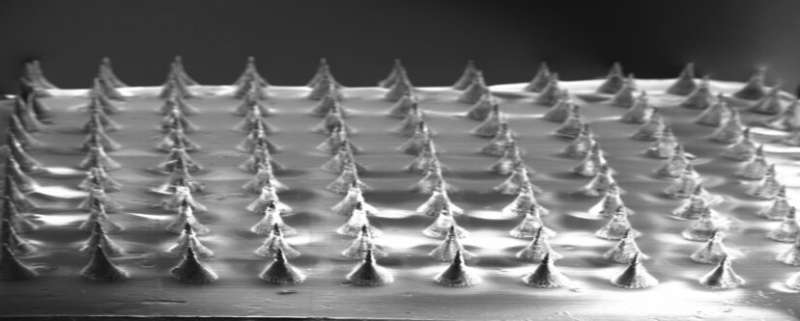Microneedles for therapeutic gene delivery

There is great potential in gene therapy for treating certain types of cancer and genetic defects, immunological diseases, wounds and infections. The therapies work by delivering genes into the patients' cells, which then produce therapeutic proteins to treat the affliction.
When determining the method of delivery for these genes, there are advantages to choosing a local, rather than systemic delivery of the genetic material. With systemic delivery, there is the possibility of unwanted tissue accumulation or of the genetic material becoming unstable. It is also advantageous to target the skin as a site for local delivery, as it is easily accessible and contains fluid and lymph vessels, as well as immune cells upon which the genetic material can act to initiate treatment.
Despite these advantages, it is still difficult to deliver genes into the skin. An ideal gene delivery approach must be able to deliver the genetic material without producing inflammation or toxicity in the body and should be able to penetrate the skin layer effectively.
A collaborative team, which includes a group from the Terasaki Institute for Biomedical Innovation, has recently published an approach based on microneedles that meets these challenges. These microneedles are made of a biocompatible material mixed with nanoparticles containing therapeutic genes. This mixture can be molded into a microneedle patch array for application to the skin. The microneedles are biodegradable, so once they have penetrated the skin, they will release the nanoparticles upon needle degradation. Moreover, the timing and sustainability of this release can be controlled by adjustments in the biomaterial preparation.
The team conducted extensive tests to optimize the release and performance of the gene-containing nanoparticles, and they also validated the efficacy of the genes. "This biodegradable microneedle patch with gene-delivering nanoparticles is an effective and minimally-invasive vehicle for local therapeutic gene delivery," said Terasaki Institute Fellow Wujin Sun, Ph.D., who is an author of the publication. "This platform can be utilized for applications such as vaccinations, protein supplementation or gene editing."
The development of these microneedles illustrates the potential for similar gene delivery systems that can be customized according to the therapeutic genes chosen. This new technology can provide a more effective way to treat skin and other cancers, skin-related cosmetic needs or diseases such as psoriasis and muscular dystrophy. It can even be used as a method for vaccine delivery against such diseases as skin or breast cancer, influenza or COVID-19.
"The ability to enable local therapeutic gene delivery using this microneedle system is a notable achievement," said Terasaki Institute Director and CEO Ali Khademhosseini, Ph.D., who is the senior author of the paper. "It opens the possibilities for a variety of clinical applications and synergizes with a number of platforms at the Terasaki Institute, which aims to leverage our ability to find personalized solutions for patients.
More information: Moyuan Qu et al, Biodegradable microneedle patch for transdermal gene delivery, Nanoscale (2020). DOI: 10.1039/D0NR02759F
Journal information: Nanoscale
Provided by Terasaki Institute for Biomedical Innovation





















